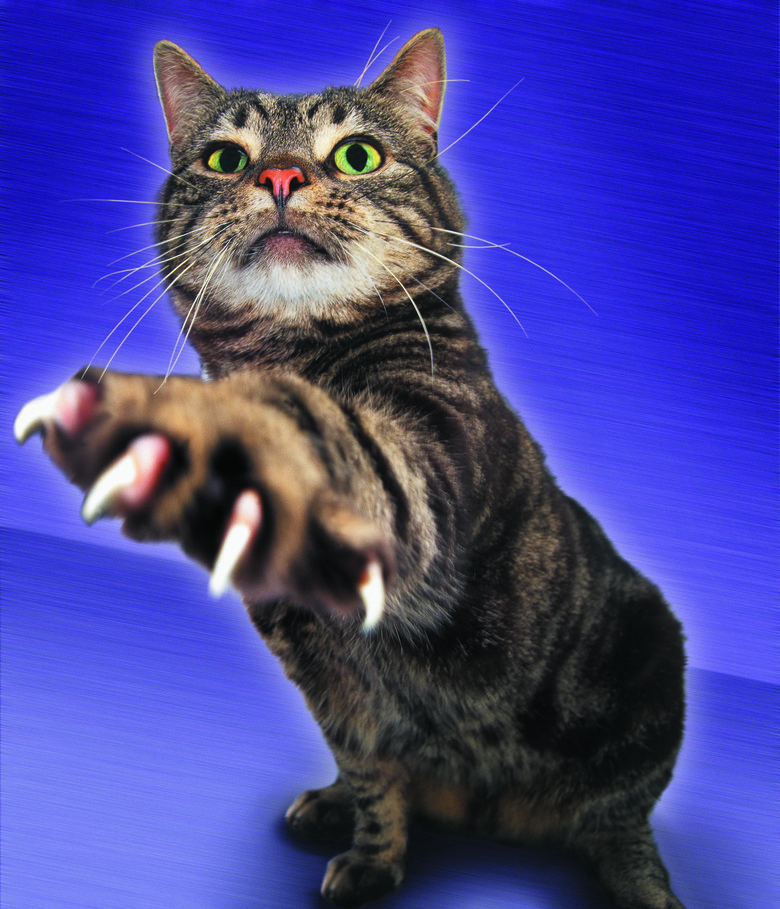How To Repair Cat Claw Marks On Leather Furniture
We may receive a commission on purchases made from links.
Cuteness may earn compensation through affiliate links in this article.
Leather furniture makes it easy to keep pet hair at bay by just wiping it away. However, if your cat takes a liking to sharpen its claws on the material, your cozy couch or chair could quickly end up looking tattered and torn. Learn to repair scratches on leather — and prevent further damage — to keep your furnishings in fine form.
Evaluate the scratches
Evaluate the scratches
Typically, there are two types of scratches left by cats on leather furniture, according to Furniture Clinic. The first is a shallow and generally straight set of scratches, usually on a cushion, from your cat raking its nails when it stretches or bolts. The second type is from punctures left by your cat sharpening its claws on a vertical surface, usually the corner or arm of the piece. Each type of scratch has its own specific way to eliminate unsightly damage.
Quick and easy minor repairs
Quick and easy minor repairs
Light scratching to cushions or other surfaces are easily concealed using a commercial repair kit. Choose a single dominant color leather repair kit such as Fortivo Leather Repair Kits. Several shades of the dominant color allow you to blend to match your own couch and come recommended by Bob Vila as the best overall leather repair kits.
The good news is that your couch isn't ruined. First, clean the scratched area with rubbing alcohol and a cotton swab, advises Fortivo. Use the spatula included in the kit to smooth the matched solution to the scratches. Once the area has completely dried, use rubbing alcohol and a cotton swab to buff and blend the area, using light pressure to feather and blend the edges.
Prepare puncture marks
Prepare puncture marks
When cats sharpen their claws on the arm of a leather chair or surface, they commonly pull fibers from the leather through the holes, leaving them protruding from the surface of your furniture. Don't trim these away, advises Leather Repair Company, or you will leave holes that will compromise the strength of the leather.
Instead, use a spatula made for applying fillers such as COLOURLOCK Stainless Steel Spatula. After thoroughly cleaning the area with rubbing alcohol, drag the spatula over the surface of the leather to make all the snags stand straight up. Then, apply leather glue such as Leather Restore Leather Glue Adhesive to the area, wiping it into the base of the pucks in the same direction you scraped to make them all stand up.
Next, use your spatula in the opposite direction, causing the snags and pucks to lie down flat into the adhesive you just spread across the area. Pushing them down flat against the surface creates a stronger repair and avoids creating weaknesses or holes.
Sand, fill, and color
Sand, fill, and color
After the adhesive dries — about 20 minutes — sand it lightly with 300 grit or 1200 grit sandpaper. Don't worry about getting it completely smooth, the idea is to remove most of the roughness.
Apply heavy filler to the area such as AT-X Leather Repair Filler Compound for Leather Restoration, making sure it gets deep into any holes or tears caused by your cat's claws. When dry, sand it down using 1200 grit sandpaper until smooth.
Wipe away any dust particles before applying Furniture Clinic Leather Recoloring Balm or another leather-safe colorant. Use circular motions to apply the first coat to ensure it penetrates completely. Let it dry completely — you can speed up the process by using a hair dryer — and apply one to two more coats until you are satisfied with the color.
Seal and protect
Seal and protect
Finish your project by sanding lightly with the 1200-grit sandpaper and apply a clear sealant if desired. Sealing your couch with Fiebing's Acrylic Resolene Leather Finish Protect or another sealer can extend its life for years.
Keep in mind, though, that by sealing your couch, you're reducing its absorbent qualities. That's a good thing when it comes to repelling animal urine or spilled sodas. However, should you need to make another repair, your couch will no longer absorb the product.
Consider transparent adhesive products to train your cat not to claw your furniture, such as Stelucca Amazing Shields Furniture Protectors from Cats. The shields are slick and eliminate the satisfaction cats get from clawing the furniture.
